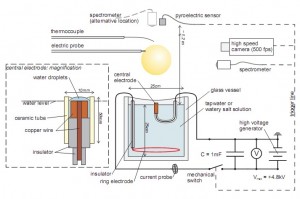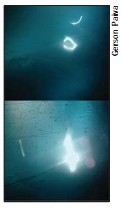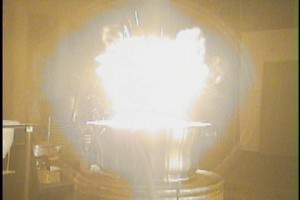Sep
16
Power From Ball Lightning?
September 16, 2008 | 9 Comments
One of the most mysterious phenomena is ball lightning. If some scientist’s theories are correct it could be powering large-scale reactors and could go a long way to solving the world’s energy needs. The latest is the joint study group led by Gerd Fussmann at the Max Planck Institute and Berlin’s Humboldt University who has generated ball lightning like plasma clouds with luminous circular spirals at diameters of 10 to 20 centimeters. Inside these spirals is a plasma cloud of ionized gas or a “quantum nucleus” was observed, leaving scientists stunned at the potential energy gain given the relative size of the experiment.
According to plasma-based explanations of ball lightning, the huge amount of energy deposited by a lightning strike vaporizes and then ionizes material on the ground or in the air, creating a gas of positively charged ions and negatively charged electrons. The highly energetic electrons collide with both ions and neutral atoms and molecules in the gas, exciting these particles so that they then emit radiation as they drop back down to a stable energy level.
Simple enough, but there are a number of problems with this type of theory; the most significant being the inability to explain how the plasma can last for so long. Ions and electrons within plasma usually recombine within microseconds of the external energy supply being switched off, and yet eyewitnesses claim to have seen atmospheric ball lightning that can last for many seconds after the initial lightning strike. Then its also unclear how ball lightning manages to remain a discrete object – the plasma generated inside fusion reactors, for example, needs to be confined using enormous magnets. And ball lightning remaining close to the ground is a puzzle because the plasma would be much hotter than the surrounding air and would rise very rapidly. Understanding the self-stabilizing nature of lightning balls could be great use in fusion confinement.
Fussmann simulated the effect of a lightning strike on a small pool of water. They inserted two electrodes into a large beaker filled with water, with one of the electrodes surrounded by a ceramic tube. Using a powerful capacitor bank they then sent a current of some 60A through the water, which caused the water within the tube to evaporate and ionize. The result was a blob of plasma that hovered over the water for about 0.3 of a second after the current was switched off. He admits that he has little idea of why the group’s luminous ball lasts for as long as it does, but he believes that the energy stored in chemical bonds between atoms in the plasma must be at least partly responsible for sustaining the effect. Fussmann thinks that multiplying the 8 kJ of energy released in the lab experiment electrical discharge by a factor of about 1000 – thereby bringing it in line with the energy of a typical lightning strike – then it might be able to create fireballs that last as long as those seen in nature.
A key aspect of the experiment is that a piece of paper placed above the plasma does not burn. Fussmann concludes that the plasma is enclosed in a “cold skin”, which would match with a theory put forward by David Turner, a retired physical chemist living in Maryland. Building on the work of the Russian physicist Igor Stakhanov. Turner’s model is of one type of chemical process supplying energy to the plasma while another cools its surface. The first chemical process explains the reported longevity of ball lightning, while the second can account for its ability to remain close to the ground – the cold surface allows ions within the plasma to bind with airborne water molecules and so weigh down the sphere.
Vladimir Bychkov of the Institute for High Temperatures in Moscow theorizes a lightning strike can convert a variety of organic materials present in vegetation and soil into long polymer molecules that link up with each other to form a ball. Such balls, he says, could build up huge amounts of electrical energy on their surface that then ionizes the surrounding air, producing orange or blue coronas. Bychkov has produced fireballs 10–20 cm in diameter and with lifetimes of up to half a second by sending electric discharges through samples of wax and resin. Similarly, John Abrahamson, a chemical engineer from the University of Canterbury in New Zealand thinks that ball lightning forms when a lightning strike heats up a solid material to the point of vaporizing it.
Antonio Pavão and Gerson Paiva at the Federal University of Pernambuco in Brazil have in fact produced long-lived fireballs using a slightly different method. Pavão and Paiva sandwiched a piece of silicon 0.3mm thick between two electrodes, and applied a voltage of 20–25V. Then they raised the top electrode; thereby creating an electric arc from which luminous spheres the size of table tennis balls flew out in all directions lasting up to 8 seconds.
Peter Handel of the University of Missouri in St Louis, “maser-soliton” theory builds on the work of Russian physicist Pjotr Kapitsa, who shared the 1978 Nobel Prize for Physics for his work on low-temperature physics. In 1955 Kapitsa proposed that microwave radiation emitted from a lightning strike would generate a standing wave, and that air near an antinode in this wave would be ionized and result in a small, glowing ball of plasma. Handel’s theory is the electric field pulse from a lightning strike generates a population inversion in the rotational energy levels of water molecules. This in effect creates a maser – the microwave equivalent of a laser – in a certain volume of humid air. At an antinode of the standing wave generated within this maser the electric field breaks down and creates a soliton – a particle-like state of a solitary wave, which glows as ball lightning.
Yoshi-Hiko Ohtsuki of Waseda University in Japan has verified Handel’s theory. Ohtsuki passed windowpanes and ceramic tiles through a simulated ball-lightning discharge without extinguishing the discharge. However, some researchers, like Karl Stephan of Texas State University, are skeptical of Handel’s theory. Stephan, who last year reported that he had produced luminous fireballs in a microwave cavity, believes that microwaves of the power needed for Handel’s maser-soliton mechanism have never been observed in nature.
All the while Dr. Kiril Chukanov has been working at his take on ball lightning as an over unity device that expels more energy than consumed to drive it. With patents in hand Dr, Chukanov is offering third party researchers the information to confirm his claims. His description is ball lightning represents a “Giant Macro Atom” composed of a two-dimensional quantum nucleonic nucleus and a three-dimensional electronic shelf cloud. After about 15 years of hard work on ball lightning he says he’s found a way to extract, harness, and channel the quantum free energy.
This gives us three scenarios. The first is that ball lightning may have attributes that could be integrated into fusion research. The second is the microwave or “maser-soliton” has value in energy creation or even in materials processing. Third is that Chukanov is right and way ahead with net energy output. One has to wonder if any of these has legs, but the academic results are putting a floor of sorts under Chukanov.
One thing is clear, plasma technology is seemingly understood and products have been out for decades, but there is still a great deal to know in the field of plasma. Ball lightning and the energy potential it offers might be a great field for the future.
Comments
9 Comments so far





Wow this is a great resource.. I’m enjoying it.. good article
I’ve just started off a blog, the knowledge you give on this site has aided me extremely. Thank you for all your time & work.
I was just having a conversation over this I am glad I came across this it cleared some of the questions I had.
Great read. Thanks for the info!
Intriguing post. I have been searching for some good resources for solar panels and discovered your blog. Planning to bookmark this one!
Of course, what a great site and informative posts, I will add backlink – bookmark this site? Regards, Reader
I would like to say “wow” what a inspiring post. This is really great. Keep doing what you’re doing!!
Great post! Smart guy! Ball lightning is unusual phenomenon not understood by conventional physicists, because ball lightning is new, unknown by conventional science, kind of matter: 2-dimensional quantum object. In side the ball lightning nucleus there is no space, no material substance. Ball lightning nucleus is real black hole – nothing inside, absolute emptiness!
Sorry Kiril Chikanov,
However the nucleus is a string knot (not baryonic) of magnetic monopole photons.
Simple?
Three photons in each knot is enough.